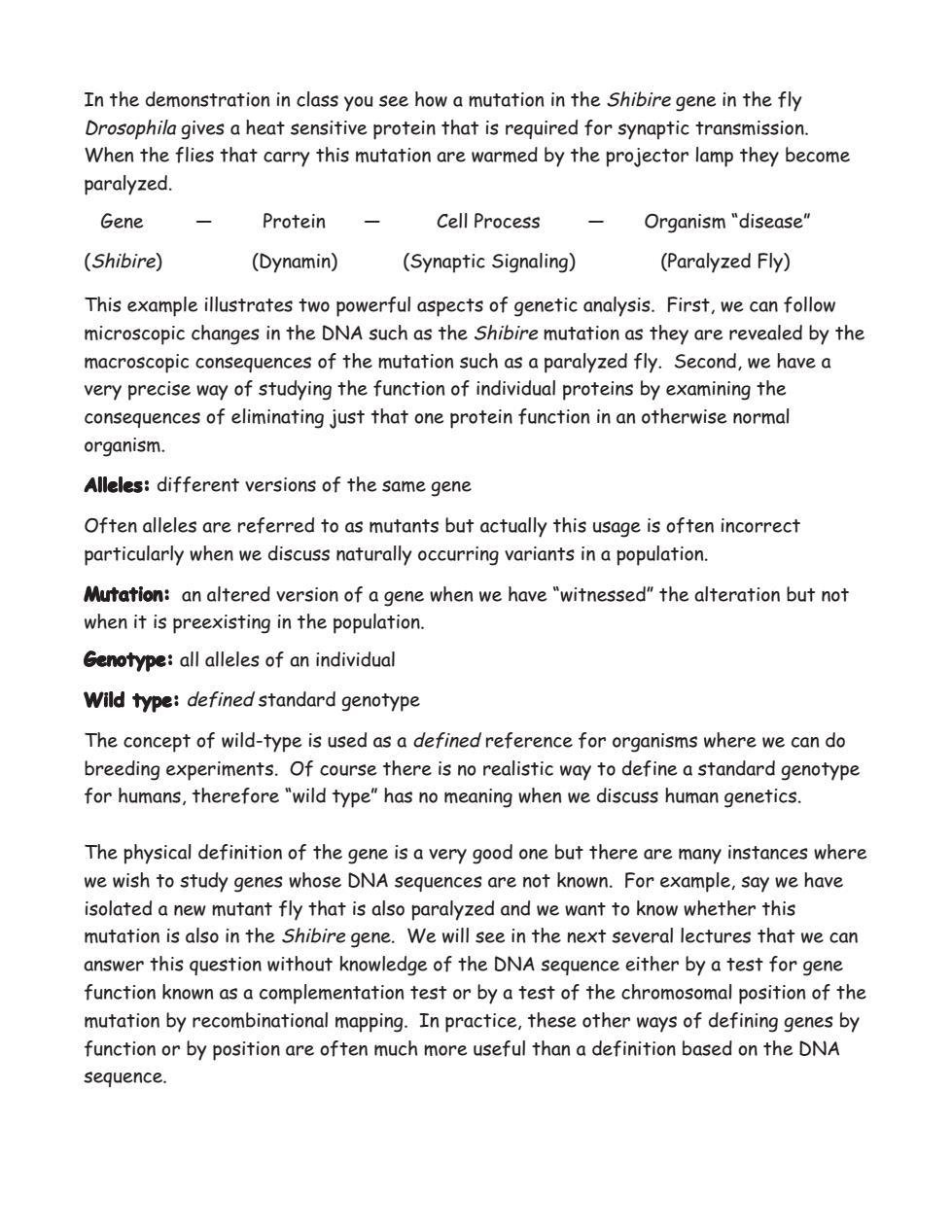正在加载图片...

In the demonstration in class you see how a mutation in the Shibire gene in the fly Drosophila gives a heat sensitive protein that is required for synaptic transmission. When the flies that carry this mutation are warmed by the projector lamp they become paralyzed. Gene Protein Cell Process Organism "disease" (Shibire) (Dynamin) (Synaptic Signaling) (Paralyzed Fly) This example illustrates two powerful aspects of genetic analysis.First,we can follow microscopic changes in the DNA such as the Shibire mutation as they are revealed by the macroscopic consequences of the mutation such as a paralyzed fly.Second,we have a very precise way of studying the function of individual proteins by examining the consequences of eliminating just that one protein function in an otherwise normal organism. Alleles:different versions of the same gene Often alleles are referred to as mutants but actually this usage is often incorrect particularly when we discuss naturally occurring variants in a population. Mutation:an altered version of a gene when we have "witnessed"the alteration but not when it is preexisting in the population. Genotype:all alleles of an individual Wild type:defined standard genotype The concept of wild-type is used as a defined reference for organisms where we can do breeding experiments.Of course there is no realistic way to define a standard genotype for humans,therefore "wild type"has no meaning when we discuss human genetics. The physical definition of the gene is a very good one but there are many instances where we wish to study genes whose DNA sequences are not known.For example,say we have isolated a new mutant fly that is also paralyzed and we want to know whether this mutation is also in the Shibire gene.We will see in the next several lectures that we can answer this question without knowledge of the DNA sequence either by a test for gene function known as a complementation test or by a test of the chromosomal position of the mutation by recombinational mapping.In practice,these other ways of defining genes by function or by position are often much more useful than a definition based on the DNA sequence.In the demonstration in class you see how a mutation in the Shibire gene in the fly Drosophila gives a heat sensitive protein that is required for synaptic transmission. When the flies that carry this mutation are warmed by the projector lamp they become paralyzed. Gene — Protein — Cell Process — Organism “disease” (Shibire) (Dynamin) (Synaptic Signaling) (Paralyzed Fly) This example illustrates two powerful aspects of genetic analysis. First, we can follow microscopic changes in the DNA such as the Shibire mutation as they are revealed by the macroscopic consequences of the mutation such as a paralyzed fly. Second, we have a very precise way of studying the function of individual proteins by examining the consequences of eliminating just that one protein function in an otherwise normal organism. Alleles: Alleles:Alleles: different versions of the same gene Often alleles are referred to as mutants but actually this usage is often incorrect particularly when we discuss naturally occurring variants in a population. Mutation: Mutation:Mutation: an altered version of a gene when we have “witnessed” the alteration but not when it is preexisting in the population. Genotype: Genotype:Genotype: all alleles of an individual Wild type: defined standard genotype The concept of wild-type is used as a defined reference for organisms where we can do breeding experiments. Of course there is no realistic way to define a standard genotype for humans, therefore “wild type” has no meaning when we discuss human genetics. The physical definition of the gene is a very good one but there are many instances where we wish to study genes whose DNA sequences are not known. For example, say we have isolated a new mutant fly that is also paralyzed and we want to know whether this mutation is also in the Shibire gene. We will see in the next several lectures that we can answer this question without knowledge of the DNA sequence either by a test for gene function known as a complementation test or by a test of the chromosomal position of the mutation by recombinational mapping. In practice, these other ways of defining genes by function or by position are often much more useful than a definition based on the DNA sequence